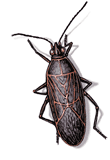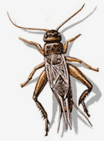Other Pests
 Box Elder Bug - Leptocoris trivittatus
Box Elder Bug - Leptocoris trivittatus
Appearance: Box elder bugs are up to 1/2-inch long Color ranges from gray to black with red criss-crossing stripes on the wings. The nymphs have bright red abdomens.
Habits: A number of insects have discovered that heated buildings are ideal to survive the cold of winter. Such pests include box elder bugs, cluster flies, and lady beetles.
As the weather cools in late summer and early fall, the sun warms the southern and western walls of buildings. The warmth attracts these insects to buildings where they crawl inside cracks and stay there for the winter. During warm winter days, some insects "wake up" and end up on the inside of the building.
Diet: Box elder bugs feed on maple and box elder trees and usually infest buildings where these types of trees are nearby.
Reproduction: Once box elder bugs begin to infest a tree, their population will grow from year to year. You will notice them gathering in massive numbers on the tree bark, limbs and the immediate ground around the tree.
Other Information: Although boxelder bugs don't bite, they will make a mess. Their droppings will accumulate where they are roosting and their eggs will appear as a series of small sacks.
Millipede - Superclass Myriapoda
 Appearance: Millipedes have a segmented body, short antennae, and many legs. Each body segment has two pairs of legs that stick out from the sides of the body (each segment is really 2 segments fused together). Most millipedes have from 25 to 100 segments (47 to 197 pairs of legs); most have about 30 to 40 segments (and 57 to 77 pairs of legs). The legs move in a wave-like motion.
Appearance: Millipedes have a segmented body, short antennae, and many legs. Each body segment has two pairs of legs that stick out from the sides of the body (each segment is really 2 segments fused together). Most millipedes have from 25 to 100 segments (47 to 197 pairs of legs); most have about 30 to 40 segments (and 57 to 77 pairs of legs). The legs move in a wave-like motion.
Habits: They are found under logs and stones, in moist soil and under leaf litter. They usually avoid light.
Diet: Most millipedes are herbivores (plant-eaters) that eat dead and decaying plant material, but a few are also carnivores (meat-eaters). Millipedes also occasionally eat moist, living plants.
Reproduction: Millipedes hatch from eggs - hatchlings have only the first three pairs of legs. There is some maternal care of the eggs. Millipedes molt (shed their old exoskeleton) as they grow - with each molt they gain more segments and legs.
Other Information: Millipedes are distinguished from centipedes by the presence of two pairs of legs per body segment. They shun the light and tend to hide under logs and other debris, and will often burrow into the ground. Their hard exoskeleton affords some protection against predators. When threatened, they will coil up in a ball to protect the more vulnerable underside. Some also have a noxious secretion used to deter predators. Eyesight is poor to non-existent in millipedes. They sense by way of their antennae which continually tap the ground as the millipede moves along.
Centipede - Class Chilopoda
Appearance: Flattened, with one pair of legs on most of their segments; segments number from 10 to 100; one to 1 - 1/2 inches long; various colors.
Habits: Usually live outdoors beneath damp accumulations of leaves, stones, boards, etc; occasionally find their way into homes, where they hide in moist basements, damp closets and bathrooms; when disturbed, they run swiftly.
Diet: Insects and spiders.
Life Span: Some species live as long as 5-6 years.
Other Information: Large jaws can bite humans, but the bite is seldom worse than a bee sting.
Cricket - Acheta domesticus
Appearance: Varies, though usually no larger than 1-1/2 inches in length. Color is generally black or brown.
Habits: Nocturnal; live outdoors, but may be found indoors in warm areas, particularly the kitchen, basement, fireplace, or in cracks; make a distinctive chirping sound.
Diet: Eat or drink almost anything that is available, especially crumbs and food scraps. Some have been known to feed on and damage clothing, usually items that are soiled and awaiting laundering.
Reproduction: Eggs deposited singly in crevices and behind baseboards; 40 to 170 eggs laid at one stage; egg stage lasts eight to 12 weeks.
Other Information: May bite when captured.
Clover Mites - Bryobia praetiosa Koch
 Appearance: Clover mites are only 1/64th inch long, soft, oval, and flattened from top to bottom. They vary in color from rusty brown to dark red. A distinguishing characteristic is the very long pair of front legs that extend forward like antennae as the mites crawl.
Appearance: Clover mites are only 1/64th inch long, soft, oval, and flattened from top to bottom. They vary in color from rusty brown to dark red. A distinguishing characteristic is the very long pair of front legs that extend forward like antennae as the mites crawl.
Habits: Clover mites are a temporary nuisance; they appear suddenly and then are gone. Doing nothing and tolerating some clover mites are an option. Clover mite swarms usually last for only a few days to a few weeks at the most. They are always gone by late July.
Diet: Clover mites are plant feeders only. They feed on sap from grasses and clover, and are especially numerous in lawns with a heavy growth of succulent, well fertilized grass. They do not cause any apparent harm to turfgrass, however their feeding activity can turn the grass a silvery color and may stipple plants when heavy populations are present.
Reproduction: Clover mites develop from unfertilized eggs (no males needed). Females lay about 70 eggs each, singly or in masses, in cracks and faults in concrete foundations, in mortar crevices, between the building walls, under loose bark of trees, and other protected places. Eggs lay dormant during the hot summer, hatching in early autumn when temperatures fall below 85 degrees F, followed by two nymphal or resting stages and the adult. Each stage lasts two to six days, and the life cycle is completed outdoors in one month with two or more generations per year. Mites may live one to seven months depending on climatic conditions. Most mites overwinter as eggs, but all life stages can be present. Overwintering eggs hatch in early spring.
Other Information:
 Earwig - Order Dermaptera
Earwig - Order Dermaptera
Appearance: 5/8 inch long, dark reddish-brown, with yellow-brown legs; large forceps (cerci) on the end of the abdomen, which pose no threat to humans.
Habits: Found all over homes, particularly in cracks and crevices near or on the ground; active primarily at night.
Diet: Scavengers; will eat just about anything.
Reproduction: Up to 60 eggs are laid in burrows in the ground and guarded by the female; hatch in the spring.
Other Information: Many species have a gland which secretes a foul-smelling, yellowish-brown liquid when threatened.
Scorpion - Order Scorpionida
 Appearance: Range in size from 1 - 1/2 to three inches long; eight legs, a pair of large pinchers and a pair of small pinchers near the mouth; tail possesses a stinger.
Appearance: Range in size from 1 - 1/2 to three inches long; eight legs, a pair of large pinchers and a pair of small pinchers near the mouth; tail possesses a stinger.
Habits: Most active at night; during the day, they hide under bark, logs or stones; in houses, they hide in closets, shoes and folded clothes.
Diet: Small spiders and soft-bodied insects; will eat other scorpions.
Reproduction: Females produce an average of 32 young; young reach maturity in three to four years.
Other Information: Common in southern states; most species deliver a sting no more harmful than a bee's; very poor eyesight; use pinchers as feelers.